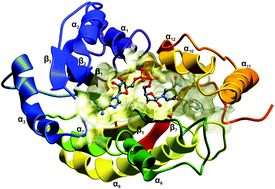The quantum biophysics of the isoniazid adduct NADH binding to its InhA reductase target
Abstract
Mycobacterium tuberculosis (MT) is the aerobic bacterium responsible for the infectious disease tuberculosis (TB). Among the several anti-TB drugs, the first-line anti-TB prodrug isoniazid (INH) has the most potent bactericidal activity. After INH activation by the catalase-peroxidase (KatG) enzyme, the isonicotinic acyl–NADH (INADH) complex is created, which interacts with the enoyl-acyl carrier protein reductase (InhA) active site inhibiting the MT activity. However, mutations in the InhA gene can reduce the InhA–INADH affinity, thus decreasing the large benefits of INH in TB treatment. To provide a deeper understanding of the mechanisms responsible for the anti-TB INADH activity, we study the InhA–INADH interaction using a density functional theory (DFT) quantum mechanical approach. The interaction energies are calculated using the molecular fractionation with the conjugate caps (MFCC) scheme, which allows the quantification of, through the residues’ binding energy, their individual role in the binding pocket, as well as the other relevant residues near the InhA binding site. Besides the importance of amino acid residues with charged lateral chains, our results unveil the role of structural water molecules in the InhA–INADH binding energy. Among all the amino acids in the InhA, we highlight I21 and S94 due to their relevance to the INADH activity after specific InhA mutations. I21 and S94 are strongly bonded to the INADH with an energy of −33.4 kcal mol−1 and −23.1 kcal mol−1, respectively. These values and the positions of I21 and S94 residues relative to the INADH indicate that the ribose of adenine and pyrophosphate groups in INADH strongly influence the total INADH–InhA interaction and consequently the INH anti-TB activity. All reported results contribute to a deeper understanding of the INADH–InhA binding that can be explored in the design of new antitubercular drugs.


 Please wait while we load your content...
Please wait while we load your content...